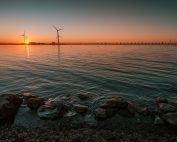Wind power has by far the lowest production cost of the types of power that can be expanded quickly and on a large scale. Only wind power can be expanded as quickly as needed to meet the electricity demand until the year 2030, writes Svensk Vindenergi’s CEO Daniel Badman in a reply to SvD Debatt on November 25, 2023 .
No, offshore wind power is not ten times more expensive than nuclear power. This and other claims made by PO Eriksson, Peter Mellberg, KD Sundberg and Leif Östling on 21/11 in SvD about wind power must be addressed. Because the reality looks very different compared to what the debaters give the impression of.
The measure that is usually used by reputable organizations such as the IEA (International Energy Agency) to compare the cost of different types of power is levelized cost of energy (LCOE). It is measured in öre per kilowatt-hour and is an amalgamation of capital, operating and system costs distributed over the expected production – over the entire lifetime. LCOE thus shows which electricity price the facility needs to break even. Wind power clearly has the lowest LCOE and is the type of power that can be expanded to such an extent and in as short a time as is needed to meet the electricity demand by the year 2030.
Another method of comparison is to look at the need for a subsidy or guaranteed price. It shows what level of income is needed for an investment decision to be possible. The debaters raise Britain as an example, which is good. There is current information for both offshore wind power and nuclear power. The most recently completed auctions for offshore wind power have a government price guarantee of less than 60 öre per kilowatt hour. The reactors in Hinkley Point C have a government price guarantee of around 120 öre per kilowatt hour, i.e. twice as much as offshore wind power. Offshore wind power is thus not ten times more expensive than nuclear power.
The debaters give the appearance of knowing more about the investment conditions, in an industry where none of them currently operate, than today’s active investors. In addition, they keep a close eye on the size of the investment. With their background, they naturally also know that there is a big difference between investment and cost.
We can state that the investment interest in wind power in Sweden remains high. For the fourth quarter in a row, we see new investment decisions. In the years 2020–2026, 36 terawatt hours of wind power will be added in Sweden. The total investment for these projects is SEK 125 billion – without government subsidies. In addition, there are a large number of projects in the early planning stages. No other powerhouse has such a project pipeline.
There is reason to recall that in the wind farms’ environmental permit there is a requirement to set aside funds for dismantling and restoration. The provision must usually be made in connection with the start of operations. In the wind power industry, we believe that wind power, like nuclear power, should be allowed to be phased out.
With more wind and solar power in the electricity system, the price of electricity will vary more than before. A varied electricity price motivates both companies and private individuals to adjust their electricity use. Those who cannot or do not want to adjust consumption can always sign an electricity contract with a fixed electricity price. In Sweden, and in many other countries, both electricity producers and electricity-intensive companies ensure that they acquire some form of price protection, for example through a long-term electricity trading agreement (PPA, power purchase agreement). PPA is nothing new. They began to be used in the United States 100 years ago to finance the expansion of coal power, and the contract models are constantly evolving.
New electricity production with low production costs, i.e. wind power, puts significant pressure on the price of electricity, and the extensive wind power investments of the 2000s have contributed greatly to Sweden’s low electricity prices compared to other countries. The report Vindkraften’s electricity price depressing effect 2022–2025 shows that an additional terawatt hour of wind power depresses the annual average price of all electricity by 0.4 öre per kilowatt hour.
Wind power’s electricity price depressing effect contributes to a dream situation for all electricity users. It lays the foundation for industrial investment where electricity at a competitive cost is a necessity. Of course, the debaters, with a solid background in business, are well aware of how important the electricity price is for industry.
Source: Swedish Wind Energy Association














